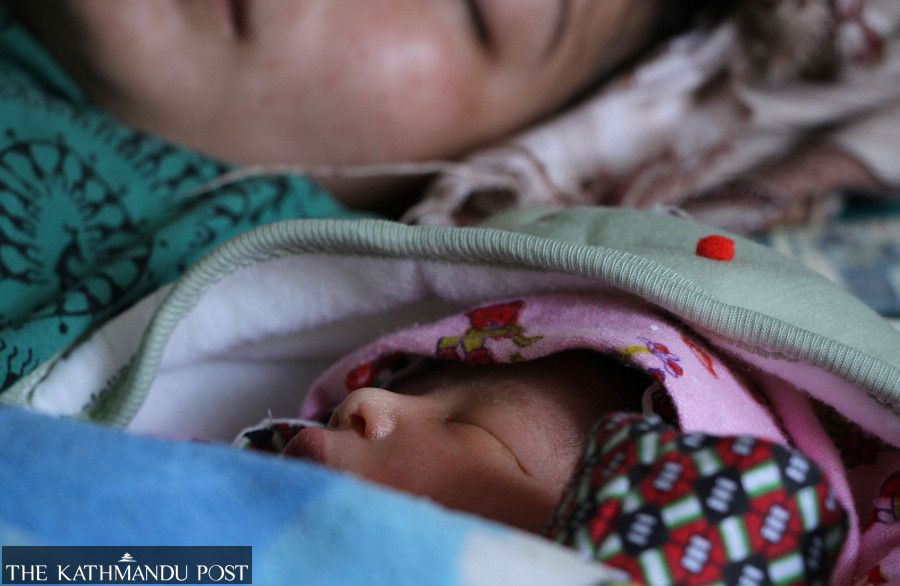Health
Despite preventive efforts, maternal deaths still high
Thirty-two women died in two months, government records show. Excessive bleeding after childbirth is a major cause, say health workers.
Arjun Poudel
A few months ago, a 26-year-old woman who had just given birth and was suffering from excessive bleeding was brought to the Thapathali-based Paropakar Maternity and Women’s Hospital in an ambulance.
When the woman from Dhading district was brought to the hospital, she had shortness of breath and due to excessive bleeding her blood pressure level was so low that doctors had to struggle hard to insert an intravenous cannula.
“All the signs and symptoms indicated that the woman was in very serious condition,” said Dr Amir Babu Shrestha, director at the hospital. “We somehow managed to save the mother but could not save her baby.”
This was a common refrain among the doctors at the hospital, as they often encounter such cases. Excessive bleeding after childbirth, also known as postpartum hemorrhage, is the most common factor leading to the death of new mothers in the country.
According to the Family Welfare Division under the Department of Health Services, 32 women died across the country between June 15 and August 16 during childbirth.
“Postpartum hemorrhage was responsible for a majority of the deaths,” said Nisha Joshi, a senior public health officer at the division. “Most women died on the way to the hospital or immediately after reaching the hospital. Delay in medical intervention is another factor for the high number of deaths during childbirth.”
The World Health Organisation said postpartum hemorrhage is the leading cause of maternal mortality in low-income countries and the primary cause of nearly a quarter of all maternal deaths globally. Most deaths resulting from the said complication occur during the first 24 hours after birth.
The UN health agency said that the majority of these deaths could be avoided through the use of prophylactic uterotonics during the third stage of labour and by timely and appropriate management.
In the fiscal year 2021-22, 118 women died of birth-related complications, according to the Ministry of Health and Population.
Nepal has to reduce maternal deaths to 116 per 100,000 births by 2022 to meet one of the Sustainable Development Goals.
The country has already missed its own 2020 target to reduce maternal mortality to 125 per 100,000 births. The country had reduced the maternal mortality rate from 539 per 100,000 births in 1996 to 239 per 100,000 births in 2016—for which the country even received the Millennium Development Goals award.
The health target under the UN’s Sustainable Development Goals is to reduce the maternal mortality rate to 75 for every 100,000 births by 2030.
Officials concede that maternal deaths have not been declining and several factors including postpartum hemorrhage posed challenges in meeting the target.
Pre-eclampsia and eclampsia (pregnancy-related high blood pressure disorders) are other causes of maternal deaths.
Maternal health experts say tear in the cervix or tissues of the vagina, tear in a blood vessel in the uterus, bleeding in hidden tissue area or space in the pelvis, blood clotting disorders, and placenta problems are among the causes of the postpartum hemorrhage.
“But delay in taking the patients to hospitals on time is the main reason for the high number of deaths due to excessive bleeding,” said Shrestha, director at the Paropakar Maternity and Women’s Hospital. “If the patient is brought to the hospital on time, her chances of survival increase significantly.”
Officials at the Family Welfare Division, however, said some maternal deaths are being reported from hospitals also as women sometimes die despite timely medical intervention.
The Ministry of Health and Population has launched various programmes including free institutional delivery service, travel allowances for opting institutional delivery, and antenatal visits. The Ministry has also distributed misoprostol, a medication used to treat postpartum bleeding, to new mothers through female community health volunteers in 52 districts.
The ministry also sends trained nurses to individual households to provide postnatal care to new mothers and airlift complicated cases from remote areas.
“Despite many efforts, the number of maternal deaths due to excessive bleeding is high in our country,” said Joshi, an official at the Family Welfare Division.
Maternal health experts say the number of women dying from excessive bleeding during and after childbirth is very high in developing countries like Nepal.
“Failure to diagnose the problems on time, provide timely medical help, and lack of access to expert care are the main reasons for the high maternal deaths from excessive bleeding and infections in Nepal,” said Dr Bhola Rijal, a senior consultant obstetrician and gynecologist. “Our own experience shows that maternal death rate will not lessen by superficial efforts. We must find a practical solution to the problems, that is timely expert care.”




 5.39°C Kathmandu
5.39°C Kathmandu













%20(1).jpg&w=300&height=200)
